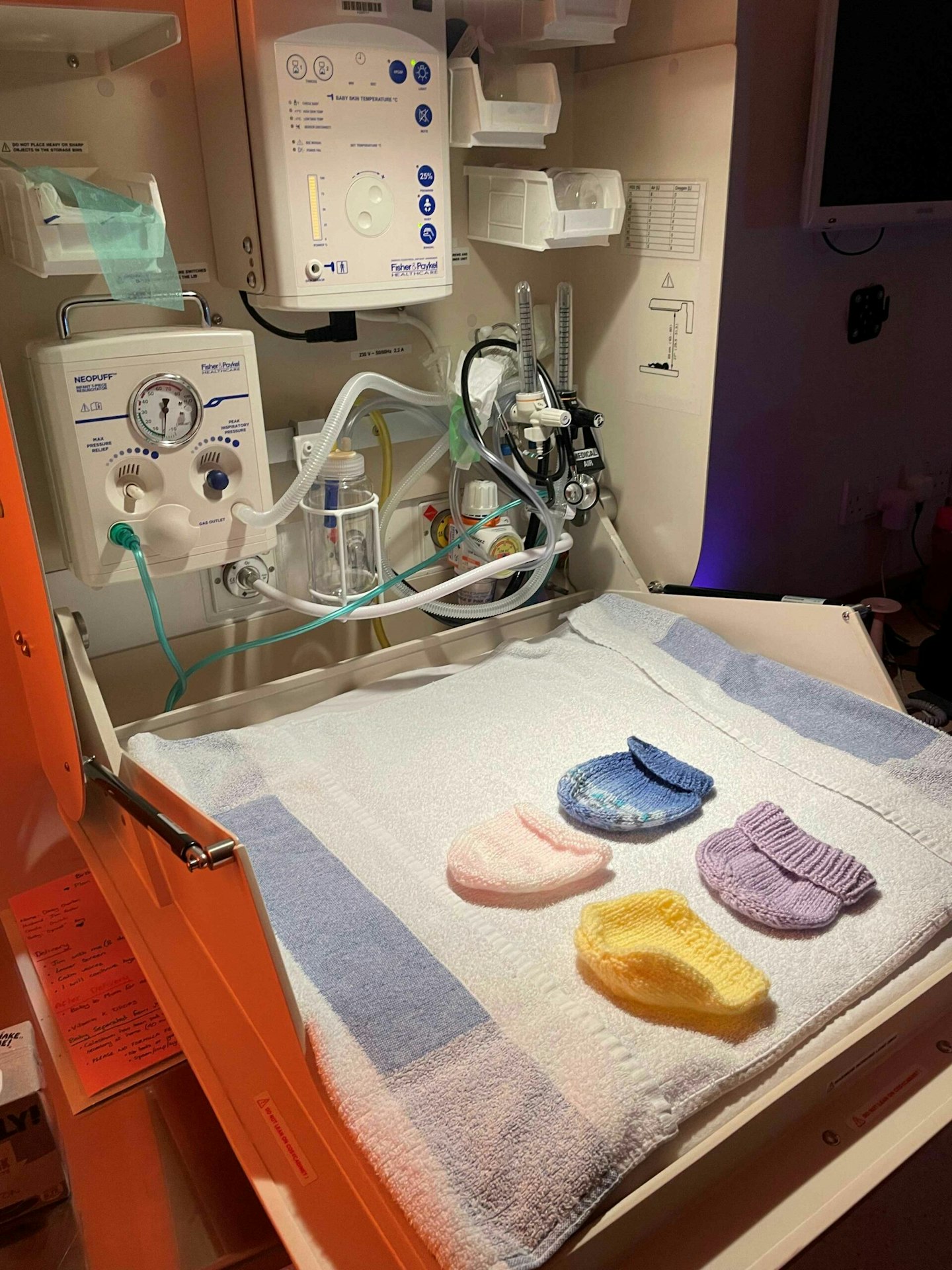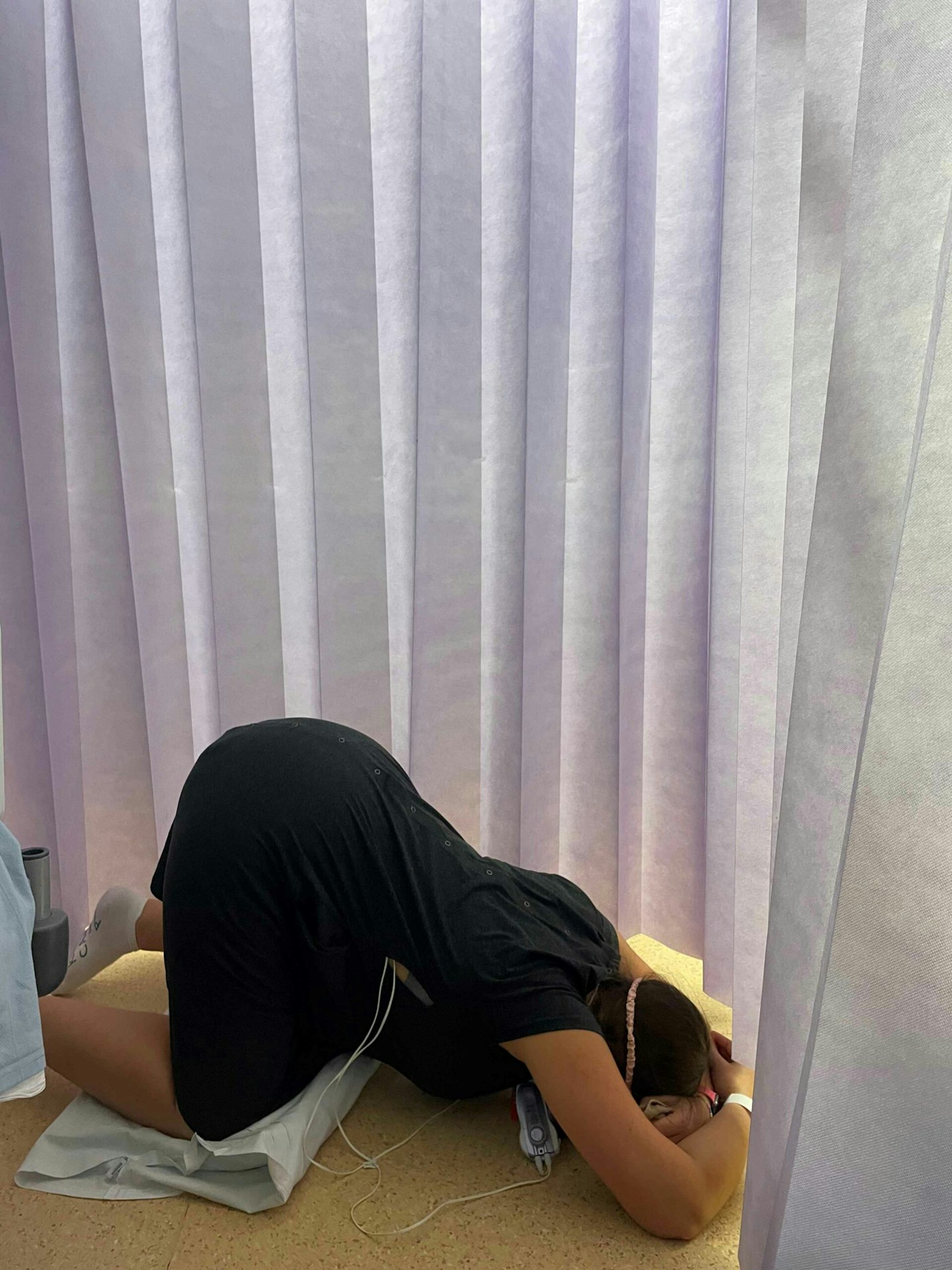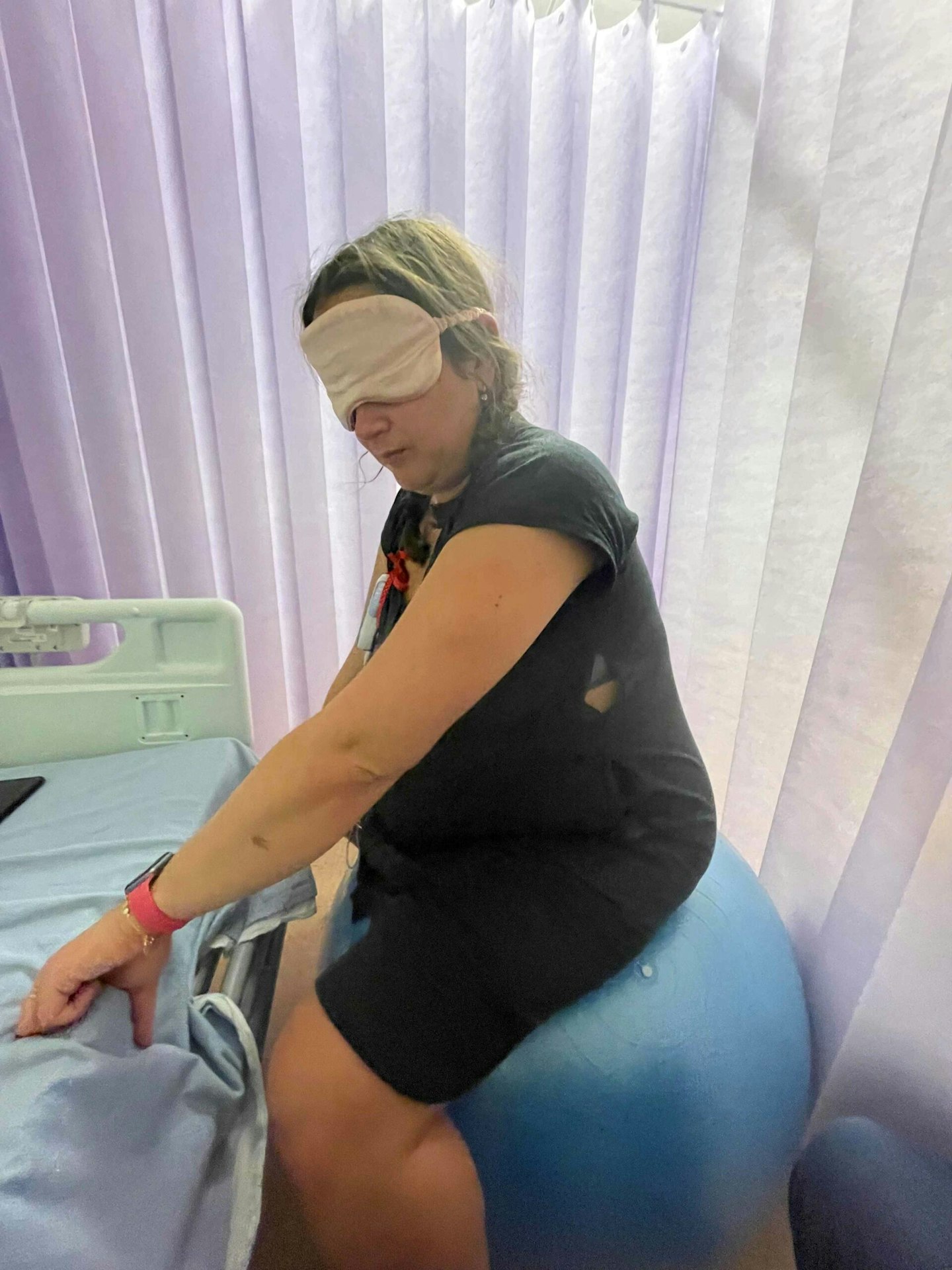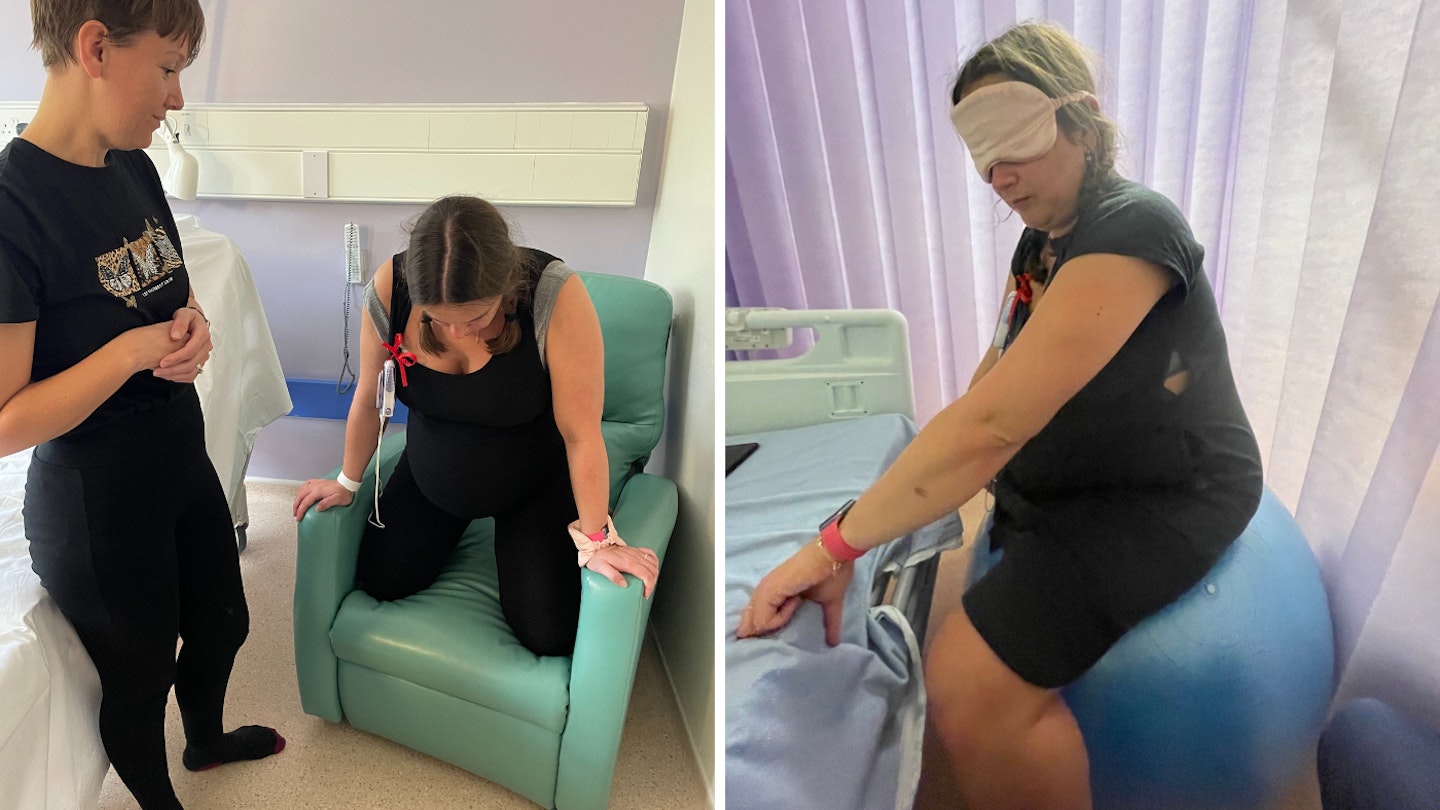Welcome to my blog on the rollercoaster that is new fatherhood. I’m Jim, my wife’s name is Daisy, I turned 50 last September and Daisy is a spritely 38. We had our first child in October 2023 – hence this, The Geriatric Dad Blog!
This is a proper, ‘in real life’ read from a man's perspective, so I hope you enjoy it and follow the series as we go. This time: our birth experience (part 2)!
Saturday morning trip to the hospital
It was early on a Saturday morning in mid October, 2022.
Daisy's contractions had started almost 24 hours earlier on Friday morning - and were now getting closer together, anything from 3 to 5 minutes apart, lasting a minute or more.
They were extremely painful.
I'd never heard anything like the noises she made as each contraction kicked in and worked itself through. She cried and cried, making guttural screams of anguish. I felt utterly helpless and cried briefly on occasion myself, but only when she couldn't see. I couldn't allow her to see any kind of weakness in me.
We'd spoken to the labour ward on the phone and they'd recommended coming in.
The drive to Hinchingbrooke Hospital (Hinch) from our house took around 45 minutes, a bit longer than all the practice runs thanks to getting stuck behind a tractor on the A47.
I took it gingerly and drove with both my hands on the steering wheel - not too fast, not too slow, acutely aware of the traffic around us, senses heightened.
We got to the hospital ok. Pulling up at the entrance, I knew the procedure:
• Escort Daisy to the ward
• Get her admitted & comfortable
• Park the car in the long-term car park
• Get the overnight bags from the boot
• Get back to the ward
• Commence further daddy-support duties
Preparation for this moment had been fastidious. Daisy (as usual) had thought of everything. The bags contained changes of clothes, aromatherapy kit, essential massage oils, energy foods, snacks and supplements, plenty of fizzy water (she craved fizzy water), a couple of blankets, noise-cancelling headphones, spare batteries for the TENs machine she was using for pain relief, bathroom stuff, baby clothes for Mr Sprout - everything you can think of. They'd been packed and by the front door ready to go for weeks.
We walked up to the labour ward and pressed the buzzer to be admitted. Immediately, we were greeted with smiling, caring faces behind the admittance desk. I noticed Daisy's name on the board as we confirmed who we were, before being ushered into a birth room.
Our birthing room
The room we'd been allocated was comfortable if ageing slightly in terms of decor. Some tiny, newly knitted woollen hats were on a shelf. Perhaps one of them was destined for Mr Sprout's head! There was a gas and air machine, various monitors, cupboards full of medical kit - I scoped it all, taking in the surroundings. We might be here a while.
A comfy-looking chair was by the side of the bed. I got into it and discovered it reclined nicely - I'd be able to lie down and possibly even get some sleep (!) if it turned out to be a long delivery.
Daisy got onto the bed. She was smiling: excited and happy in the pain-free lulls between contractions. A few moments passed before a midwife came in.
We had a brief chat about how things were: when contractions had started, how long they were lasting now, how much of a gap was between them. How painful they were.
She read Daisy's birth plans - all three of them, from our best-case birthing scenario through to what we'd like if everything went pear-shaped.
"The birthing pool is available," she exclaimed, on seeing that this was Daisy's preferred way of bringing Mr Sprout into the world. Things were looking good.

Intimate examination
Once all that was sorted, the midwife requested giving Daisy an intimate examination to see how dilated her cervix was - perhaps the best indicator of how imminent birth might be.
While Daisy was completely within her rights to refuse (correctly they aren't forced on any woman) at this juncture we both felt it would be good to know exactly where we were.
Daisy's thinking was clear. Because she was in so much pain, more than she'd anticipated, the examination would help her decide whether to proceed with birth plan a), which involved the pool, or plan b), which involved greater medical intervention and an epidural. So we agreed.
The midwife firstly externally examined Daisy's belly to feel baby's position (all seemed good, Mr Sprout was head down where he should be) before 'lubing-up' her hand, gently inserting it between Daisy's legs and - er - doing her 'thing'.
I winced. Daisy winced. The midwife looked into thin air, a concentrated frown on her face as she felt her way around inside Daisy's vagina and up to the cervix.
It was intrusive but over as quickly as it had begun. Out came the hand, off came the glove with a sharp elasticated 'snap' - a couple drops of lube flying across the room - and out came a summary of where we were in the whole birthing process.
It wasn't good news. Daisy was only 1cm dilated. ONE PALTRY CENTIMETRE!
All that effort and pain to get to this point. All that pain. Absolutely no sleep for Daisy in more than 24 hours. Yet it appeared we were still very much in the latent phase of labour. And who knew how much longer it might go on.
Daisy was devastated. She cried. I tried to support her as best I could. We'd assumed, with the contractions being as strong as they were and as close together as they were, she was much further along.
"I'd recommend you go home..."
The midwife looked at us, almost apologetically. "We can't admit you to the labour ward," she said (guidelines are 4cm cervix dilation before this happens). "I'd recommend you go home and come back later when the contractions are even closer together."
Daisy was in agonising pain, every five minutes, for at least a minute at a time. And we were being told to go home, with no painkillers being offered, other than paracetamol you can buy in a supermarket, and the TENs machine she was wired up to?
We again referred to the BRAIN acronym to help us decide what to do.
• Benefits: Home is a nicer environment. We could watch TV. Daisy would be more likely to build her levels of oxytocin, which is supposed to be very helpful in achieving a smooth birth.
• Risks: If something was wrong, or did go wrong, we were 45 minutes away - it'd likely be a blue-light job to get her back to the hospital and we might end up in Leicester, or Peterborough, not our chosen hospital.
• Alternatives: We enquired what the alternative to going home was and were told they would happily admit Daisy to the antenatal ward, where there were beds available (it was a shared ward).
• Instinct: Both our instincts told us we needed to be in the hospital. Neither of us could explain why, but - even at this point - we both felt something wasn't quite right and that hospital was the place we should be
• Doing Nothing: We could have stayed in the labour ward - I don't think they would have physically kicked us out - but the ward was busy and we didn't want to clog up a room for another expectant mum who might need it sooner
We made the call - based on our instincts - to stay in the hospital and move to the maternity ward until Daisy was far enough along to get admitted back onto the labour ward.
The midwife left the room to go and make the necessary arrangements.
The antenatal ward
An hour later and we were in the antenatal ward, in a room with six beds, three of which were occupied (including Daisy).
One lady was being induced by oxytocin drip, the other under close observation in the final stages of her pregnancy because she had high blood pressure brought on by pre-eclampsia.
It seemed odd that they would put Daisy in a room with women in totally different stages of late pregnancy, who weren't even in labour. How could they relax with Daisy's primordial screams of pain resonating through the room?
They were lovely about it, but still - it was hardly ideal. So, after a few hours we asked a nurse if any private rooms were available we could pay for, just on the off-chance. We'd not been told that there were, so were delighted when the reply was 'yes' - and that it would cost £80 for the night. We booked it.
Daisy and I wondered why this facility wasn't more widely marketed (we never did find out the answer to that, but if you are able to afford to pay for a private room, it is ALWAYS worth asking the question whether one is available in your local NHS hospital maternity unit, if you want a bit of privacy).
Paperwork sorted, forms filled, we relocated for a second time into a far more suitable private room - complete with its own en-suite toilet, shower and TV.
It was late Saturday afternoon and Daisy had been in labour for well over 24 hours. And it had been a lot longer than that since she'd had any sleep.

Night 2 - Extended 'latent' phase
Time passed slowly, laboriously even (excuse the pun). Afternoon melted into evening and the day slowly saw itself out. The contractions kept coming, relentlessly, wave after wave in a storm of pain.
Our doula, Sarah, who was being a tower of strength and knowledge for us, popped home for a bit. Then came back. I ordered a couple of Domino's pizzas, delivered to reception - a spicy pepperoni job for me, a vegan supreme for Daisy.
The delivery man turned up on time but wouldn't give us our pizzas, because the postcode I'd inputted into the app didn't match the postcode at the main hospital entrance. He relented after I showed him I'd paid for them on my app - and after we'd had a 'discussion' that was probably more heated than the jalapenos on my pizza.
The Saturday night dragged, as the Friday night before had. Minute followed minute, hour followed hour. We watched some TV. I got a bit of sleep in the reclining chair. Daisy got none. I ate some pizza. Daisy drank her fizzy water and ate the odd energy bar after the pizza.
Contraction followed contraction followed contraction. All painful, all between 3 and 5 minutes apart. We'd been warned in our NCT classes that the latent phase of labour could go on for days. We didn't think that that would happen to us, though. Was it happening to us? We didn't really know.
For hours, no nurses came to see us, no midwives. We were left in our room to almost fend for ourselves. No painkillers were offered, no gas and air. Daisy just had paracetamol from Tescos - which was about as effective as a chocolate teapot at dulling the excruciating pain she was enduring.
She upped the power of the TENs machine, which helped a bit. But at times in the dead of that night, it felt like we'd been forgotten.
Then - shortly after the 8am staff changeover - I popped to the front desk to ask if we could see someone.
Passive-aggressive midwife
A midwife in a white uniform soon appeared, which I thought was unusual (none of the others were). My hackles were instantly raised. This midwife's body language didn't sit well with me. There were no genuine smiles, there was minimal empathy. Little attempt was made to establish any sort of personable connection with Daisy. It was business as usual to her, and a business she seemingly wasn't particularly interested in.
There was no "How are you this morning, are you ok? Do you want any more painkillers?"
Instead, just a perfunctory "Good morning," before she flatly and disinterestedly asked: "How long between contractions?"
"Between 3 and 5 minutes," I answered. "As they have been for 48 hours."
She looked at me as if to say, "I wanted your wife to answer that question," before requesting bluntly to do an intimate examination.
This time, Daisy refused. As is her right. The bristling nature of this midwife was antagonising both of us.
She then got her pocket watch out and held it up, right in Daisy's personal space, in what seemed to me to be a deliberately passive-aggressive action.
Obviously, she wanted to record how long the next contraction would be and the lapse in time between it and the following one. Which was ok: but it was as if she were also saying to Daisy, "Go on then. I don't believe your contractions are as close together as you're saying they are. Prove it."
Predictably, seven minutes passed before the next one kicked in. She let go of her watch, said we wouldn't be admitted to the labour ward and should consider going home. And with that, she left the room without so much as a "Call us if you need anything."
Later I found out that the white uniform signified she was an agency midwife and not part of the regular ward staff - not that that is an excuse!

Daisy admits herself to the Labour Ward
Eventually, enough was enough for Daisy. The pain, the exhaustion, the seeming lack of concern from the agency midwife on the antenatal ward. She'd had no sleep at all in over 48 hours.
More importantly, deep down, instinctively, we both felt - KNEW - something wasn't right. A particularly bad contraction was the straw that broke the camel's back, prompting Daisy to make the sudden decision to leave the private room, leave the antenatal ward and go back to the labour ward and check herself in.
Sometimes you have to fight to get the care you need. Sometimes your instinct is right and you have to follow it. This was one of those moments.
Daisy swore as she stormed out of the room: "F*** this, I need painkillers!" before striding purposely down the ward; our doula and me trailing in her wake. She exited the ward, crossed the corridor and arrived at the entrance of the Labour Ward.
She pressed the entry buzzer and knocked firmly on the door. A few seconds later it opened and the three of us walked up to the admissions desk, where a perplexed midwife greeted us kindly and asked how she could be of assistance.
Daisy just blurted it out: "Something isn't right. My contractions are agony but not getting closer together. You ARE going to admit me! I NEED gas and air!"
4cm dilated
The staff on the Labour Ward could see all wasn't well.
Suddenly, the midwives cared. Suddenly, everyone was brilliant. Suddenly, there was empathy and compassion - now we had people around us we knew we could trust. There was only a corridor between the wards, but it may as well have been a different country.
Daisy was taken through to a free birthing room. A young midwife was assigned to us - and oh my - she was fabulous, completely reassuring.
"I can see you're quite far along," she said immediately, smiling kindly, getting an immediate connection with Daisy. "Don't worry, we're not going to send you home. But I do recommend I check to see how dilated you are now."
We agreed. The answer - just about 4cm. Some progress but still, not as much as we'd have hoped. Daisy was hooked up to a monitor, gas and air were freely dispensed and we opted to abandon our preferred birthing pool option and go for plan b) instead, which involved an epidural to help alleviate the pain.
Epidural
The midwife agreed to this request following a quick assessment of Daisy's condition and, within a very short time, the anaesthetist arrived with her paraphernalia and administered the epidural.
The relief Daisy felt once the procedure had taken effect was instantaneous. She relaxed. Her anxiety faded. I chilled out a bit. My wife was pain-free for the first time in more than 48 hours.
Yes, she could still feel the contractions - we could see them, and their intensity, on the monitor she was hooked up to - but the pain was gone. I removed the TENs machine patches from Daisy's back, switched the machine off and put it back in its box ready to return to the hire company.
The epidural enabled her to have some food, drink some juice and get some rest. Not much rest, but enough to recuperate a bit and regain some energy, ready hopefully for a trouble-free delivery.
Now it was back to the waiting game. More time passed and our midwife's shift ended as the afternoon faded into another evening. A new midwife took over, who was equally as lovely. She read the notes in a handover, read our birth plan (ignoring the now defunct request for a water birth) and gave us further reassurance.
But worryingly, as this new shift progressed, Daisy's contractions were not getting closer together. They were still happening 3 to 5 minutes apart but, if anything, were becoming less powerful.
Night 3 - Amniotomy and oxytocin drip
We were told we had a couple of options to try and speed the process along:
1) Have Daisy's waters broken for her (an amniotomy) or...
2) Get her on a hormone (oxytocin) drip; the aim of which would be to make the contractions more powerful and therefore accelerate the process
As usual, we asked about the likely benefits, risks and alternatives, as it was us that would have to make the call on how to proceed, based on options and advice given to us.
Benefits of the amniotomy: It may speed things up. And would potentially allow more accurate monitoring of baby's health, through the attachment of a monitor to the scalp.
Risks: First, an increased risk of infection. Second, a prolapse of the umbilical cord.
A prolapsed cord scared the sh*t out of me, I have to say. If it happens, it's a category one emergency and immediate c-section as baby's life is under threat. But, they are very rare.
Benefits of a hormone drip: Again, may speed things up by increasing contraction power and frequency.
Risks: We were warned that the hormone can distress some babies, but that this would be closely monitored.
We opted to go for the amniotomy first and see what happened.
Waters broken, drip administered
So it was that Daisy's waters were broken by the midwife on the Sunday evening. And so it was too that it made no difference whatsoever to the contractions: their power or their frequency.
The only thing it did help facilitate was the fitting of a monitor to Mr Sprout's scalp - which again we approved - in order to more accurately read his vitals and ensure we'd know the moment he might start getting stressed.
Late on Sunday night, the oxytocin drip was administered too. And this was when things started getting a little sketchy, as Mr Sprout did not take kindly to it.
While we'd had one-to-one midwife care throughout our stay on the labour ward, our midwife was now permanently in the room with us. She started to realise what we'd felt for a long time: that something wasn't right.
Slowly but surely, Mr Sprout's vitals indicated he was getting more and more stressed. We could see from the monitor that the time he was spending 'awake' - i.e. alert and moving about, with a fluctuating and healthy heartbeat - was decreasing. And decreasing fast.
The time he would spend resting - with a lowered, consistent heartbeat - was increasing. His pulse was visibly slowing as we watched the monitor screen. He was tired. He was giving up.
The midwife was getting visibly concerned. I too was also getting concerned. My eyes were glued to the monitor - watching his heart rate, his activity, watching as he gradually became less and less active.
The registrar popped in on a more frequent basis, to keep us updated on what was going on and to talk to our midwife in hushed, calm tones about what they suspected was happening.
Then sh*t got real as blood started to pour out of Daisy's catheter.
Bleed in the bladder
Quickly, it seemed there was more blood than urine. The registrar rushed in to have a look.
It was the last warning sign the staff needed, the proof that our instinct had been right all along - something was indeed very wrong. Mr Sprout was stuck. His head was butting into Daisy's bladder and was causing a bleed, made worse with every passing contraction.
Daisy's body was trying to expel something that couldn't be expelled. Our baby was not going to come out vaginally. His life was now in danger.
"We would advise a c-section as soon as possible," said the obstetrics registrar calmly, without disguising her concern.
It was our choice whether or not to proceed with that recommendation, of course. The obstetrics team would do whatever we asked. But after almost four days of labour, both Daisy and I knew things had finally come to a head.
One last time, we used the BRAIN acronym to help us make the right decision, as we'd done throughout the entire labour:
• Benefits: An immediate c-section gave the best chance of delivering our baby safely
• Risks: No surgery is without risk - and a c-section is major surgery
• Alternatives: Carry on attempting a natural birth
• Instinct: Both our instincts screamed, 'Get the baby out as soon as possible!!!'
• Nothing: Doing nothing would likely increase the risk of death, for both our unborn boy and my wife
A category 2 c-section was realistically the only option we had now, so we agreed with the registrar and asked her to set the wheels in motion.
Buttons were pressed, calls were made, bleepers were bleeped and almost immediately the whole delivery room filled with people: midwives, the registrar, the on-call consultant, the anaesthetist and our doula. Plus people I'd not seen before doing stuff I didn't know anything about.
They whizzed around us, talking in hushed but decisive tones, each of them knowing what they had to do. It was a superb demonstration of teamwork and expertise in motion. Calm speed was of the essence.
Sensors were disconnected from baby's head and Daisy's body, the failed oxytocin drip was taken out, Daisy was put into a gown and prepped.
Within minutes she was being wheeled onto the corridor and down to theatre. I walked alongside her, holding her hand.
"We're about to meet our baby!" she said to me, eyes half-shut, a very tired smile breaking out on her face. She was utterly spent, completely exhausted after almost three days of excruciating labour.
I smiled back in an attempt to reassure her. I don't know if I succeeded, or if I disguised successfully the adrenaline-fueled anxiety that had come over me.
It was 1am on Monday morning, October 17, 2022. The long awaited birth day of our son.
NEXT TIME: The operation itself - what it's like for an expectant dad to be in the operating theatre as his child is born. What you should expect if it happens to you!
Jim's other blogs: to read all Jim's blogs - with all the advice and experiences he and Daisy have had, through pregnancy and as new parents - find out more.
